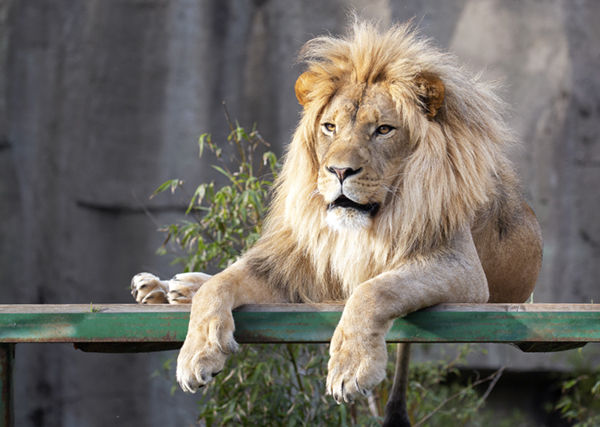African Lion
Panthera leo

At the Zoo
You can look for our lions in one of the big cat grottoes in Cat Kingdom. Lions sleep for as many as 20 hours a day, so don’t be surprised if you find them resting!
Available for Adoption!
An adoption of an African lion makes a great gift for friends, coworkers, family or for yourself!
Adopt an African lion here.

Fascinating Facts
- Hunting takes place mostly at night, and digesting large amounts of meat protein involves effort, so lions often spend as many as 20 hours a day resting.
- At a kill, male lions eat first, then females, then the cubs eat last.
- Lions are primarily terrestrial but will occasionally climb trees to rest, avoid other animals or even steal a kill from a leopard.
Physical Characteristics
Male lions weigh between 330 and 550 pounds, while female lions weigh from 265 to 395 pounds. Their head to body length ranges from 4.6 to 6.3 feet with a tail length around 3 feet. A lion coat is light tawny yellow or buff with a white belly. The male has a mane that varies in color from light tawny to dark brown to black and acts as protection during a fight. Lions’ coloration provides excellent camouflage in grassy plains and scrub country.
Lions have 9 distinct vocalizations. The roar can be heard at a distance of 5 miles and is usually heard at sundown, after a kill and after eating. The remaining sounds have not been interpreted, but appear to having meaning within the pride.
Habitat/Diet
African lions currently range in east, south and central Africa in grassy plains, savannas, open woodlands and scrub country. Their historic range was much wider. A very small Asian population still exists in India’s Gir Forest.
In the wild, lions eat wildebeests, zebras, buffalo, gazelles, wart hogs and other ungulates that may overlap its territory. If large game is scarce, they will eat small game, carrion and even domestic livestock. At the Zoo, the lions are fed a diet of fortified horsemeat, chicken and rabbits.
Social Behavior
- In the wild, lions are very social animals. The lion is the only big cat that lives in a group, or pride, which may number from 5 to 35 members.
- Female lions do most of the hunting, while the primary role of the males is breeding and protection of the pride.
- Females breed every other year but, if a litter is lost, she may breed again within a few days. A litter of 1 to 4 cubs is born after a gestation period of about 110 days. Cubs have rosette markings that fade as they mature. A female cub may remain with the pride for her entire life, but males are driven off by the time they are 3. These males often form bachelor groups until they can take over a pride of their own. Cubs have a high mortality rate and less than half survive their first year due to injury, lack of food, illness and infanticide.
Status In The Wild
In late 2015, the United States Fish and Wildlife Service added lions to the Endangered Species Act. The lion is listed as Vulnerable by the IUCN but its population is rapidly declining due to loss of habitat, sport hunting and poisoning to protect livestock interests. Human settlement is a major factor contributing to habitat loss and depletion of wild prey. Fortunately, lions are present in a number of protected parks where their numbers can be closely monitored. Additionally, these magnificent cats are vital to local eco-tourism which provides incentive to support lion conservation.
The San Francisco Zoo participates in AZA’s Species Survival Plan (SSP) for African lions and has had a successful breeding program for African lions for decades.
